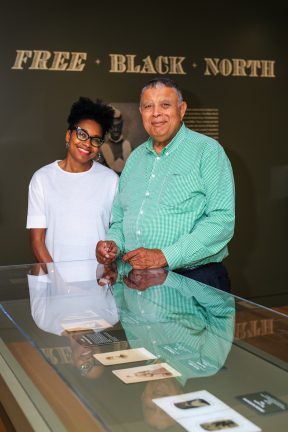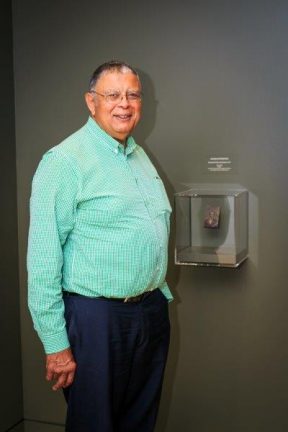A Free Black North mystery solved

David Alexander and Julie Crooks examining photographs in Free Black North. Photo: AGO
As you’ve read in the AGOinsider, our current exhibition Free Black North is an installation of close to 30 rarely seen photographs of men, women and children living in Ontario in the mid-to-late 1800s, many of whom were descendants of Black refugees who escaped enslavement in the Southern United States. The exhibition tells the story of how historically Black Canadian communities used photography as a tool to visualize and lay claim to their complex histories.
These portraits, drawn from collections at Brock University and the Archives of Ontario—many exhibited here for the first time—highlight how these mostly unknown individuals presented themselves with style, dignity and self-assurance. And now, with the help of several people, one of the subjects of these photographs is no longer unknown.
Thanks to the work of collectors Alvin McCurdy and Rick Bell, we know the subjects in these works had biographical and familial connections to the Underground Railroad and mostly settled in south western Ontario. For retired teacher and artist David Alexander, the exhibition has a deep personal resonance.
David was contacted by the AGO based on information provided by Ontario Superior Court Justice Beth Allen, who encountered a certain tintype photograph during a visit to the show. David and Justice Allen both descend from refugee slaves who settled in Amherstburg, Ontario, and her familiarity with David’s family prompted her to realized that the image of one gentleman might be of interest to him. She alerted her friend Julie Crooks, the AGO’s assistant curator of photography.
David and his wife Aruna made a special trip to the AGO from their home in Belleville to see the image for themselves. He identified the individual as his great-grandfather, John Henry Alexander. Unfamiliar with this photograph and thrilled to have discovered it, David went on to share details of his family history. John's father, Thomas, was enslaved in Kentucky before escaping to what was then Anderdon Township (now Amherstburg). Thomas married an English woman named Catherine in Ohio before settling in Anderdon. John Henry was the last of the couple’s five children. He became a teacher, and taught at the King Street School in Amherstburg and in North Buxton.
Tintypes of this era were not usually signed, so the names of the photographer and subjects are largely absent in the works featured in Free Black North. The reuniting of David Alexander with his ancestor underscores the efforts of Alvin McCurdy and Rick Bell to preserve these photographs and hidden histories in their respective collections.
Free Black North has been extended until October 1. Hurry to see it – this is one you don’t want to miss! It’s included with general admission, and AGO Members see it free.
Are you an AGOinsider yet? If not, sign up to have stories like these delivered straight to your inbox every week.
Free Black North is presented in partnership with the Scotiabank CONTACT Photography Festival.


